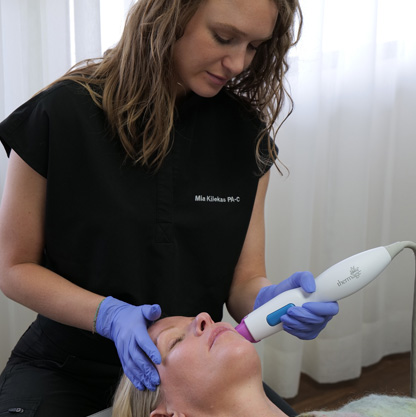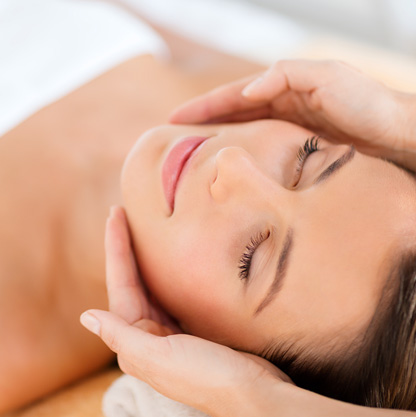
When you need to look your best — a face treatment is that gentle yet mighty intervention your skin needs. Dr. Leong does a variety of facial treatments on patients who have large pores, acne scarring, textural issues, melasma, pigmentation concerns, and more.
These treatments provide deeper and longer-lasting benefits to the skin compared to facials. Face treatments use products, equipment, and techniques that benefit various skin conditions as well. While some of these treatments go a little deeper and require a few days of recovery, most of them can be done right before a special occasion or event. Face treatments provided by Dr. Leong and her team offer people a variety of ways to achieve glowing, healthy-looking, rejuvenated skin. Each face treatment works differently to target specific skin concerns.
Different Types of Face Treatments
Chemical Peels
Chemical peels remove the dull, lifeless surface skin layers to reveal the younger, brighter skin beneath. Chemical peels can lift away lines and wrinkles, hyperpigmentation, acne scarring, and sun damage.
Many people opt for a light peel, which uses mild acids, causes no discomfort, and requires little to no recovery time.
A professionally trained nurse or physician is needed for a deeper peel to closely monitor the concentration of the active ingredients, its application, and the post-treatment protocol. The Obagi Blue Peel is one such medical-grade treatment offered at our clinic.
Obagi Blue Peel
Obagi Blue Peel offers total skin retexturizing by combining chemical exfoliators and anti-aging ingredients.
Most chemical peel treatments can be done by an aesthetician or a nurse with little to no downtime and are well tolerated by most skin types. However, the Obagi Blue Peel is a mid to deep trichloroacetic acid (TCA) peel that needs to be tailored to the nature and extent of the skin issue to be corrected. This is also why a professionally trained physician must administer the Obagi range of treatment products.
OBAGI Blue Peel is a 30 to 60 minutes outpatient treatment that may require IV sedation or general anesthesia. Depending on your skin type and the desired outcome, one to four coats of OBAGI Blue Peel solution is applied to targeted areas of the skin. The OBAGI Blue Peel then begins separation and peeling of the outer layers of the skin. Being a stronger peel, it penetrates to the deeper layers where the collagen and melanocytes are, thus treating deeper skin issues.
The Obagi Blue Peel significantly improves skin firmness, hyperpigmentation, dilated pores, and melasma. The recovery may take seven to 10 days, with some skin peeling off during this period. This deeper process ultimately reveals firm and radiant skin. Dr. Leong will advise you on the appropriate Obagi Clinical line of dermatologist-approved home skin care products to maintain your skin after your peel or other facial treatment.
Dr. Leong may combine this treatment with other anti-aging procedures like a facelift.
Microneedling
While many people wince thinking about needles, the results of microneedling make getting over your fear worth it. Microneedling creates tiny micro-channels in the skin, each only a few millimeters deep. These trigger the production of collagen and other healing factors that leave skin looking rejuvenated.
Treatments usually last less than an hour, and numbing medication is applied for deeper treatments. Superficial microneedling is performed by aestheticians for surface wrinkles and texture. Deeper microneedling requires a nurse or higher level provider; this treats acne scars and deeper lines. Some people experience tingling, soreness, or swelling after microneedling, but this goes away within a day or two.
Microneedling results are often boosted by the addition of targeted serums or PRP (platelet-rich plasma). Dr. Leong and her team will first evaluate your skin and determine the best treatment plan for you.
PRP Therapy
This treatment combines microneedling with the healing powers of platelet-rich plasma (PRP), which is rich in growth factors, to create rapid healing and regeneration of collagen. PRP comes from your own blood, it is drawn and purified before your procedure. After microneedling, the PRP is applied to the skin and allowed to sink into the microneedling channels.
Using PRP to enhance healing means that the soreness and swelling often seen after microneedling will heal faster, and your skin rejuvenation will be visible sooner.
Microdermabrasion
Microdermabrasion uses very small particles or another substance to abrade or brush away the thicker, uneven surface layers of cells to uncover newer, brighter ones. This type of skin rejuvenation treats light scarring, discoloration, sun damage, and stretch marks.
Depending on the method of microdermabrasion, this treatment can feel mild or more intense.
Laser Face Treatments
Laser face treatments are a gentle but long-term option for skin resurfacing. They work on the skin in a variety of ways; it can get hard to research and understand which one is the best for your skin problems or rejuvenation. We offer the latest, extensively-researched, and proven laser treatments to take the guessing out of your skin goals:
- Fraxel® Dual Laser Skin Resurfacing
- Lutronic LaseMD™
- Spectra™
- RF Microneedling Skin Tightening and Texture
- Thermage®
- Lutronic Clarity™ laser for Sun Spots
- eCO2™ Laser System
During the Face Treatment
For most of these treatments, you will lay back while a technician moves a wand or applicator over your face. For procedures like microneedling that may feel uncomfortable, numbing can be used. The person providing your treatment will guide you through what to expect.


Recovery and Results After a Face Treatment
After most of these treatments, recovery takes about 24-48 hours, although some may last for a few days. You should still be able to resume all your normal activities after treatment. You may see results immediately, and they will continue to improve for several weeks in many cases.
Light chemical peels and microdermabrasion get similar results but with different techniques. Peels work via chemical exfoliation while microdermabrasion uses manual or mechanical exfoliation. The difference is the treatment intensity on the skin. Medium to deep chemical peels are more intense and produce more dramatic results. Depending on the type of chemical peel you have, it may be a more aggressive treatment than microdermabrasion. If you are interested in both treatments, you can discuss their pros and cons with Dr. Leong at your consultation.




